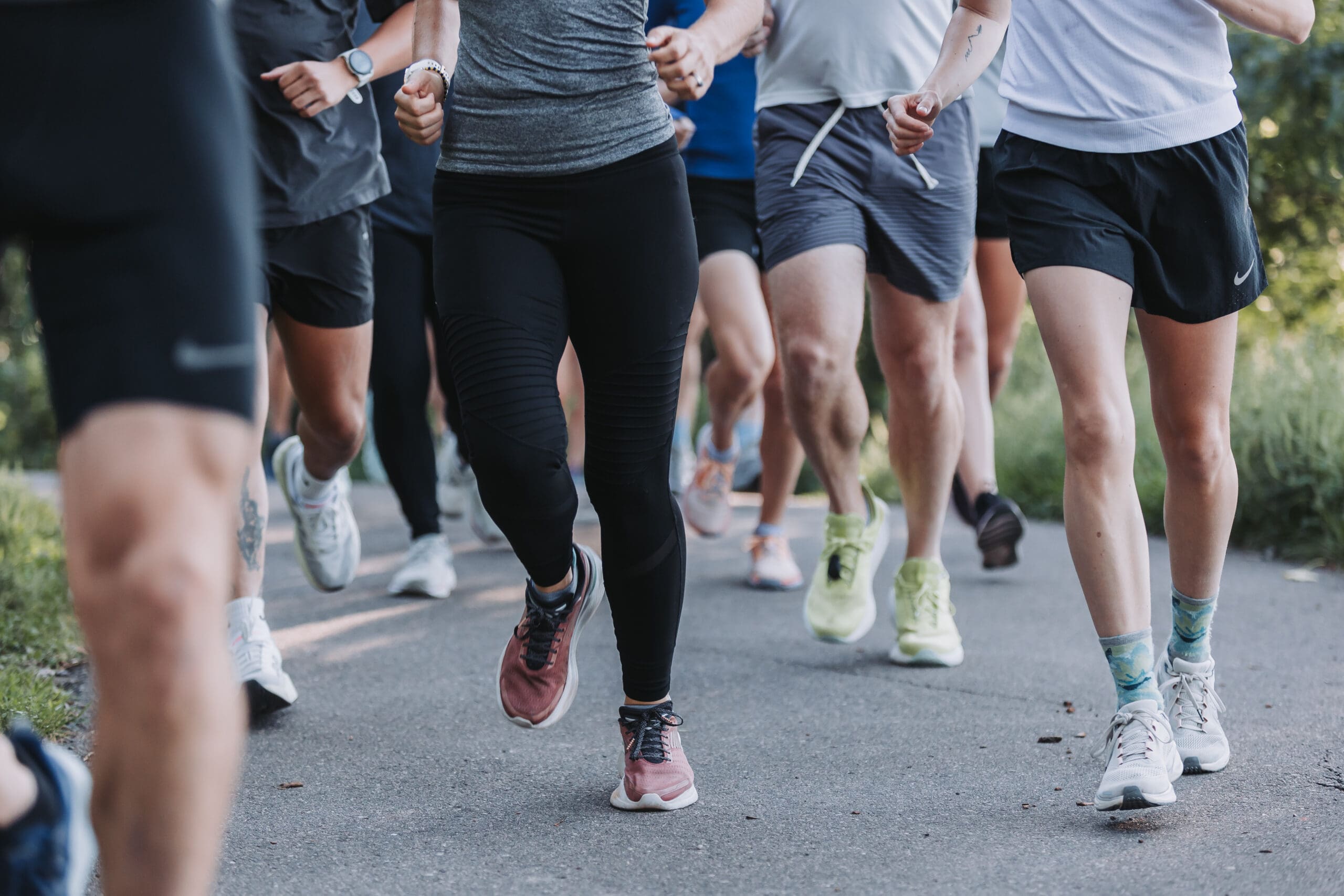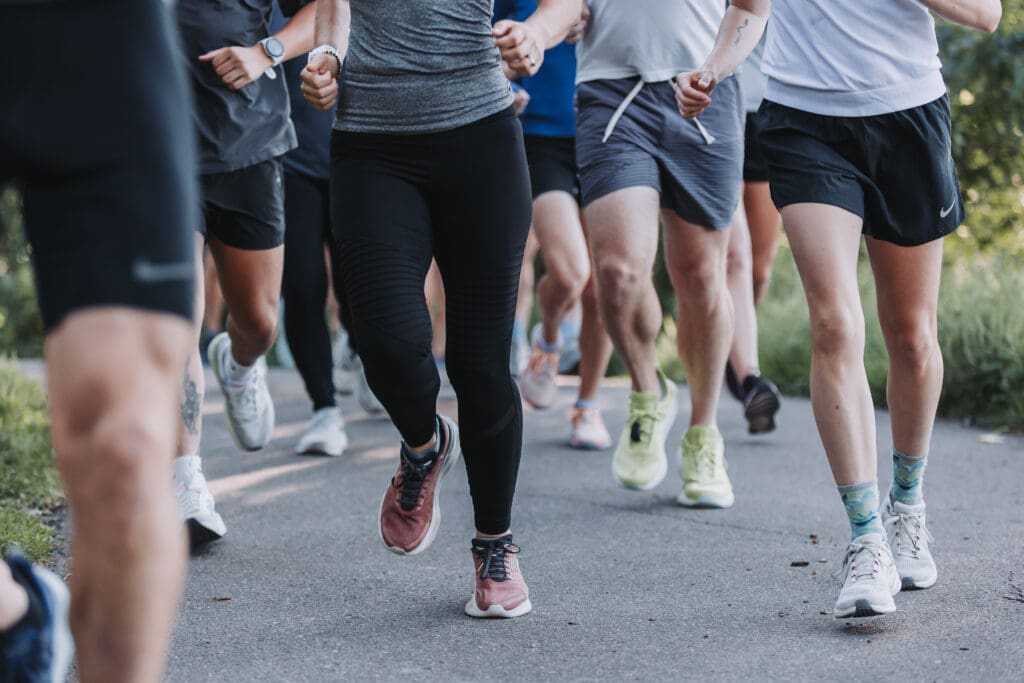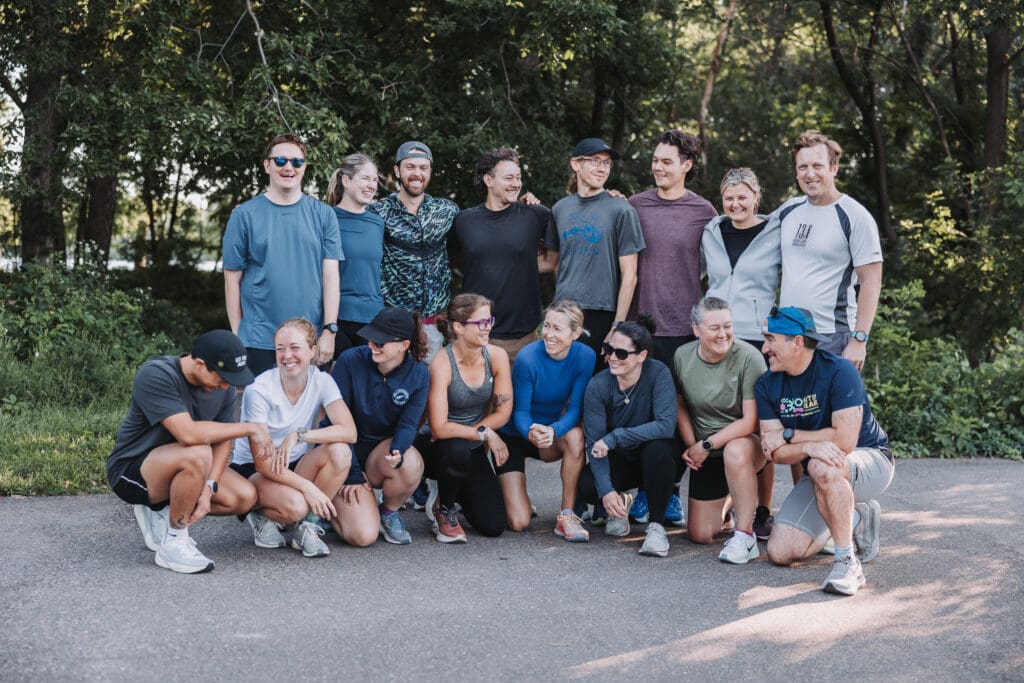
Runner’s Knee Relief: Causes, Pain Types, and Go To Exercises
September 22, 2025
Date
Category
If you have been around the running world for even a short time, chances are you have heard someone say “I have runner’s knee.”
It is one of the most common phrases tossed around in our Minnesota running community, and yet it does not actually tell us much. Runner’s Knee is a catch all term, and it can mean very different things depending on what is going on inside your body.
That is why it is so important to slow down, understand what you are actually dealing with, and then build a plan that keeps you running strong. As a Minnesota running coach and strength coach, I spend a lot of time breaking this down with athletes. Pain is not a life sentence, it is a signal. And once you know what it is telling you, you can train smarter, stay healthy, and even come back stronger.
Let’s take a closer look at the most common culprits that get lumped under the runner’s knee label, when they usually show up during our gait cycle, and a few of my go to training exercises to help you address each one.

Before We Start
At Oak Endurance, I coach endurance athletes through strength training for runners, gait work, and recovery strategies designed for injury mitigation and performance. Whether you are part of our Minnesota run coaching community or following along virtually, this guide will help you understand what is happening and what to do about it.
Disclaimer -> Before you continue reading, please know that I am not a medical doctor. The information in this blog is based on my coaching experience and is meant to provide general education and recommendations for runners. Much of what I share comes from questions I frequently get from clients, and my goal here is to provide a simple guide that anyone can learn from.
This is not meant to be a tailored or individualized program, nor should it replace professional medical advice, diagnosis, or treatment. If you are experiencing persistent or severe pain — especially the kind that does not improve with rest or feels sharp and localized — please consult with a qualified healthcare provider to rule out stress fractures or other medical concerns.
A Quick Note on Pain
One of the most important things to understand is that pain does not always equal the problem. Just because you feel pain in your knee does not mean the knee itself is the true source of the issue. In the world of sports medicine this is called the Principle of Regional Interdependence. It simply means that different regions of the body are connected, and dysfunction in one area can create pain in another. For runners this often looks like weak hips or poor ankle mobility showing up as knee pain.
This is why it is so important to work with a qualified professional who can evaluate your movement, identify weak spots, and build a plan that addresses the real cause. Treating only the painful spot might give short term relief, but it does not solve the bigger picture.
IT Band Syndrome in Runners
What it feels like: Sharp or burning pain on the outside of the knee, often showing up late in long runs or when running downhill.
Where it shows up in your gait: During stance phase, as your knee bends slightly when your foot strikes the ground.
Go To Exercises for IT Band Syndrome:
- TFL release into adductor activation
- Lateral band walks (glute med activation)
- Lateral hip hikes
- Side plank with hip abduction
The IT band itself does not stretch a whole lot. The real solution is building hip and glute strength to take the load off that tight, irritated tissue. Strength training for runners is one of the best long-term fixes.
Patellofemoral Pain Syndrome (PFPS)
What it feels like: A dull ache around or behind the kneecap. It often flares with stairs, squats, or longer runs.
Where it shows up in your gait: When your knee tracks over your foot during stance and push off.
3 Go To Exercises for PFPS:
- VMO tensioning + strength
- Single leg wall sits
- Spanish squats (band/cable behind the knees for tendon loading)
- Kneeling leg extensions
PFPS is often about mechanics and control. Gait analysis is extremely valuable here, helping you see how your knees track and where strength gaps might be. Many Minnesota runners I work with are surprised how much hip and ankle mobility affect knee tracking.
Patellar Tendonitis (Jumper’s Knee)
What it feels like: Pain just below the kneecap, right at the tendon attachment. Speedwork, hills, or plyometrics can make it worse.
Where it shows up in your gait: The push off or landing phase, when the tendon is repetitively loaded. It may also flare on downhill running when the anterior tibialis is working hard to control foot strike and eccentric load.
3 Go To Exercises for Patellar Tendonitis:
- Single leg step downs
- Anterior tibialis raises (Wall)
- Single leg wall sits
- Spanish squats (band/cable behind the knees for tendon loading)
This type of runner’s knee responds really well to progressive strength training and tendon loading strategies. Think slow, controlled, and consistent work.
Medial Knee Pain in Runners
What it feels like: Tenderness on the inside of the knee. Sometimes connected to overpronation, other times to weak hip control.
Where it shows up in your gait: From stance to push off, especially when the knee collapses inward.
3 Go To Exercises for Medial Knee Pain:
When you clean up hip strength and stability, medial knee pain often clears up right alongside it.
When It Is Not Just Runner’s Knee
A quick but important note: not all knee pain fits in these buckets. Issues with ligaments (ACL, MCL, LCL, PCL) or meniscus tears, especially past certain levels, are in a different category. Strength, mobility, and flexibility may help but it is likely not going to fix any of the above issues outside of our typical runner’s knee. If you are experiencing swelling, sharp instability, or catching and locking, that is the time to get checked out. Some of these injuries require imaging, and some require surgery.
Recovery and Support Resources
Addressing runner’s knee often takes more than exercises alone. Building strength is key, but many runners benefit from pairing that work with recovery strategies and expert guidance. Here are a few recommendations if you are looking for next steps:
- Acupuncture with Dr. Kailee Acu – Acupuncture can support recovery, reduce inflammation, and improve circulation for overworked joints and muscles.
- Gait Analysis with Oak Endurance – Understanding your running mechanics can uncover the root cause of pain and help you move more efficiently.
- Chiropractic Care with Back To Life, Dr. Tyler B. Nenaber (Golden Valley, MN) – Dr. Nenaber practices applied kinesiology and functional medicine and can help with structural alignment, muscle balancing, and whole-body health.
- Physical Therapy with Meleah Murphy, DPT – Skilled physical therapy can identify movement imbalances, restore function, and keep you running strong.
- Massage Therapy with Integrative Massage – Targeted massage can release tight muscles, improve mobility, and complement your training plan.
Pairing these services with consistent training and smart exercise work can make a big difference in your ability to run healthy and pain-free. Note that these services are specific to individuals in the Minneapolis, Minnesota area. There are tons of highly skilled practitioners around the world and I would highly recommend working with a team instead of just one person.
Bringing It All Together
Here is the big thing I want you to take away. Pain is not a dead end. It is your body’s way of asking for attention. Runner’s knee is not one single thing, and that is why it can feel so confusing. The good news is that once you figure out what is really going on, you can move forward with more confidence.
I see this all the time with athletes. When we take the time to find the actual cause, whether it is weak hips, tight ankles, or mechanics that need some tweaking, the body responds. More often than not, you come back stronger than before.
You do not have to figure it out on your own. Whether it is through coaching, specific training, or gait analysis, the goal is always the same. Understand what your body is saying so you can get back to doing what you love.
So if your knees are talking to you right now, listen in. Take it as an opportunity to learn, to grow, and to build the kind of strength that will carry you for miles to come.
Because at the end of the day, we get to do this.

Blog Post written by Jacob Oak | personal trainer, run coach, and gait analyst that works with endurance athletes through Oak Endurance
close X